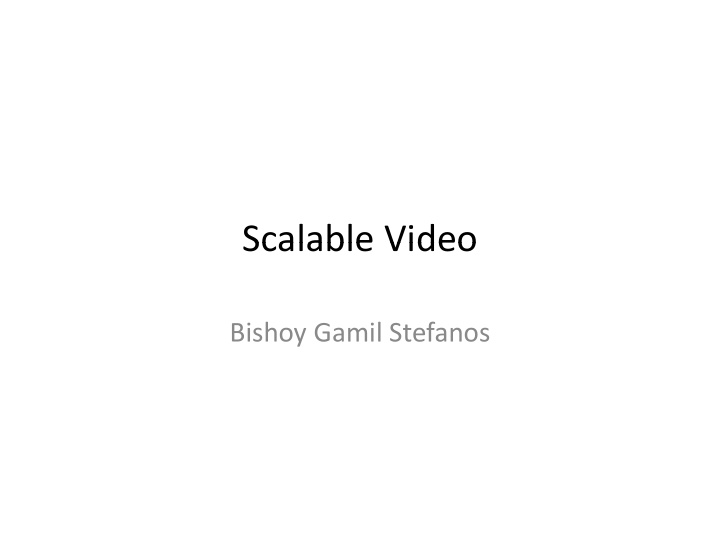



Scalable Video Scalable Video Bishoy Gamil Stefanos
Outline Outline • Introduction Introduction • Main Characteristic • Problem bl • Future Work • References
Introduction Introduction • Video Quality served to an IPod is different Video Quality served to an IPod is different than that of a PC. • Video Quality (Size) should adapt with Video Quality (Size) should adapt with network conditions. • High Quality video contains a subset High Quality video contains a subset bitstreams • The Video could reconstructed using these The Video could reconstructed using these subsets based on the requirements • Quality depends on how many subsets are Quality depends on how many subsets are used.
Main Characteristic Main Characteristic • Encoding Encoding • Encoding Decision • Adaptabilty d bil • Transmission • Decoding
MPEG MPEG • Use of standard size blocks 8x8 (MacroBlocks) • DCT (Discrete Cosine Transformation) ‐ Controlling what frequency to send ‐ Decreasing Redundancy ‐ Decreasing Redundancy • Frame predictability ‐ Intra ‐ Coded Picture (Anchor) ‐ P Pictures( Forward Predicted) decoded from previous I or P ‐ B Pictures (bidirectional) decoded from I or P ( ) ‐ frames are send out of order for B pictures to work • Motion vectors • Error vectors • Error vectors • RLE, Quantization, Huffman, etc…
Scalable Video Coding Scalable Video Coding • H.264/MPEG ‐ 4 codec • Temporal Scalability T l S l bili ‐ The motion compensation • Spatial Scalability ‐ Coding video in several resolutions and high quality could be predicted • SNR/Quality/Fidelity Scalability ‐ Video are coded in several qualities. • Combined Scalability ‐ Combination of the three
Enhancements Enhancements • Allocating more bits to region of interest (ROI) Allocating more bits to region of interest (ROI) • Assigning more bits to the region of scene ‐ cuts cuts • Increasing the speed of the motion detection i in unattended visual regions d d i l i • Parallelization of encoding/decoding and coding of I,P and B frames
Problem Problem • Coding needs more enhancements to be Coding needs more enhancements to be faster • Current codecs does not focus on the • Current codecs does not focus on the phsycovisual effects.
Refrences Refrences "Spatio ‐ temporal scalable video coding using subband and adaptive field/frame • interpolation" Yoshida, T.; Sawada, K.;Circuits and Systems, 1996., IEEE Asia Pacific Conference on 18 ‐ 21 Nov. 1996 Page(s):145 ‐ 148 g ( ) "Spatio ‐ temporal scalability ‐ based motion ‐ compensated 3 ‐ D subband/DCT video coding" • Atta, R.; Ghanbari, M.;Circuits and Systems for Video Technology, IEEE Transactions on Volume 16, Issue 1, Jan. 2006 Page(s):43 – 55 "The motion attention directed fast mode decision for spatial and CGS scalable video coding" The motion attention directed fast mode decision for spatial and CGS scalable video coding • • Wu, Y. ‐ D.; Chih ‐ Wei Tang; Broadband Multimedia Systems and Broadcasting, 2008 IEEE International Symposium on March 31 2008 ‐ April 2 2008 Page(s):1 ‐ 4 "Storyboard construction using segmentation of MPEG encoded news video" JinWoun Choi; • DongSeok Jeong; Circuits and Systems, 2000. Proceedings of the 43rd IEEE Midwest D S k J Ci i d S 2000 P di f h 43 d IEEE Mid Symposium on Volume 2, 8 ‐ 11 Aug. 2000 Page(s):758 ‐ 761 vol.2 Digital Object Identifier 10.1109/MWSCAS.2000.952867 "Adaptive rate control for streaming stored fine ‐ grained scalable video" Philippe de Cuetos, • Keith W. Ross. May 2002. NOSSDAV '02: Proceedings of the 12th international workshop on Network and operating systems support for digital audio and video "Parallelizing MPEG video encoding using multiprocessors" Barbosa, D.M.; Kitajima, J.P.; • Weira, W., Jr. Computer Graphics and Image Processing, 1999. Proceedings. XII Brazilian p p g g g Symposium on Volume , Issue , 1999 Page(s):215 ‐ 222 http://www ‐ video.eecs.berkeley.edu/erl/sccheung.html • http://vsr.informatik.tu ‐ chemnitz.de/~jan/MPEG/HTML/mpeg_tech.html •
Recommend
More recommend